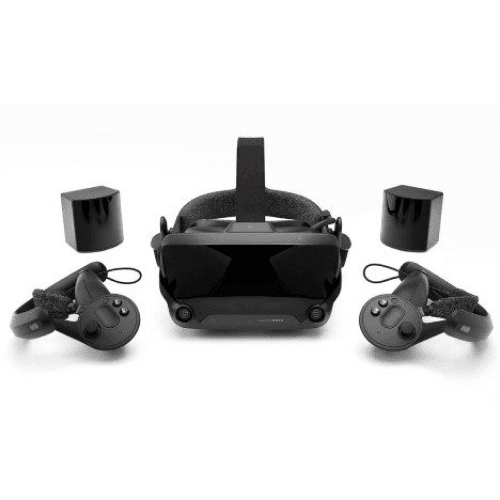
If you’re looking for the best enterprise VR headset for businesses big and small, the HTC Vive Focus 3 is a winner. A premium high-end headset with a price to match, it looks to take the best of what the HTC Vive Pro 2 offers but delivers with the flexibility and ease of use of the Oculus Quest 2.
While it’s not without its failings, the grander back-end ecosystem it offers makes up for it. If you and your company want to leverage VR on either the forward-facing consumer end, or internally for training, collaboration, design and conferencing, then the Vive Focus 3 is a confident step toward the future.
Let’s dive in for a closer look and discuss: Is the HTC Vive Focus 3 any good?
Features
The HTC Vive Focus 3 doesn’t follow in the footsteps of the premium Vive Pro 2, but the two VR headsets have walked down the same quality tree hand in hand. On paper, the Focus 3 ticks a lot of boxes.
Each lens comes in at 2448×2448 pixels per eye or 2.5K, making for a “5K” headset if you want to look at it from a marketer’s perspective. Pardon me spewing in my own mouth with that one, as it’s still impressive. It’s a 260% boost in pixels over the Focus 2 and a sizable leap over the Oculus Quest 2’s 1832×1970 lens.
The 120-degree field of view is also a boon, and while the 90Hz refresh rate is down on the Pro 2’s 120Hz, the latter is directed at gamers and the Focus 3 is not. The Vive Pro 2 is also wired.
Under the hood, we’ve got a Qualcomm Snapdragon XR2 chipset, which is exactly what you’d hope for, given it’s the only mobile chipset optimized for spatial computing. There’s also 8GB of RAM, 128GB or storage space, the ability to upgrade said storage to 2TB via a microSD card and 5G-ready Wi-Fi 6. There’s Bluetooth 5.2 too, but it kind of sucks. More on that later.
You get your six degrees of freedom with the controller, helped along by four in-built tracking cameras, a G-sensor, gyroscope and proximity sensor. Audio is supplied by two dual-driver directional speakers, joined by dual microphones with echo cancellation.
All this and it only weighs around 1.7 pounds — just 0.5 more than the Oculus Quest 2.
The business perks
I can’t understate how important it is to look at the Vive Focus 3 through the lens of a business. Yes, it has scope to cross over into the consumer space, but that’s not what it is for. And businesses, especially IT departments, will be looking for more than what you get from the best VR headsets for gaming.
With the purchase of a Focus 3, a company gets free access to 6 months of the XR Suite, which is effectively a portal to a host of apps that are designed to facilitate better learning, productivity, communication and training within a team. Vive Sync is arguably the biggest of the bunch. However, the Vive Business App Store — which is separate from the VivePort store we see with the Pro 2 — has six categories of curated apps to peruse.
You also get two free years of the VIVE Enterprise Business Warranty & Service (usually $250). And you can, of course, side-load your own company apps into the VR headset.
For your IT crew, there’s compatibility with the Android Enterprise MDM, as well as access to a device management system that allows them to manage, control and track all the Focus 3 headsets across an organization. Data is kept in-ecosystem, and it is encrypted and tracked on the headset to ensure sensitive information is kept close to the company’s chest.
These added extras aren’t a bonus; they’re accounted for in the price you pay. But they’re critical for businesses, whereas they are meaningless to gamers and general consumers.
Design
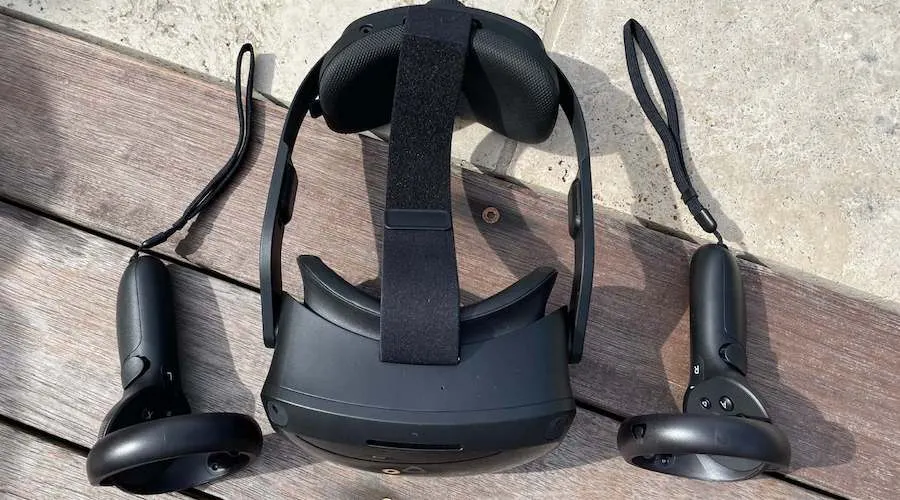
Image: Chris Stead
Try as I might, I couldn’t quite get the Vive Focus 3 to sit comfortably on my head. This despite the fact I found the Vive Pro 2 to be quite comfortable and well balanced, even with a thick cable dangling from its rear. There’s just something slightly off about it. I felt like I needed the IPD (interpupillary distance) right in close, which put pressure on my nose, and I was constantly adjusting the back, trying to find its sweet spot.
Perhaps it’s because the front visor doesn’t flick up like it does in the Vive Pro 2, meaning its rigid position doesn’t let it nuzzle into your face shape as elegantly. Or perhaps it’s a by-product of having a battery in the back of the headband. But ultimately, I never felt like I got the headset or the focus to a spot where both were comfortable.
But let’s face it; for a business use case, it’s unlikely staff or consumers will be wearing the headset for hours on end — not like a gamer might with the HTC Vive Pro 2, PSVR or Valve Index. I’m not trying to suggest they shouldn’t do better in the future, but the impact isn’t as great.
While I’m having a whinge, it’s a real shame you must remove the battery pack in order to charge it. I think most businesses would like to hot-swap between two packs, which retail for $169 each. But it would be nice to just be able to keep the unit together when it suits. You get about two hours out of the battery, regardless of whether you are playing in wireless or tethered mode. You read that right; the battery doesn’t charge even while tethered. Bummer!
Also poorly conceived is the way the App Store interface works. As of the end of October 2021, a full four months after its launch, you still can’t purchase apps from within the VR dashboard. As soon as you find something you like or want, you need to memorize a URL, then jump out to a computer and make the purchase that way. How archaic.
At least it’s sexy
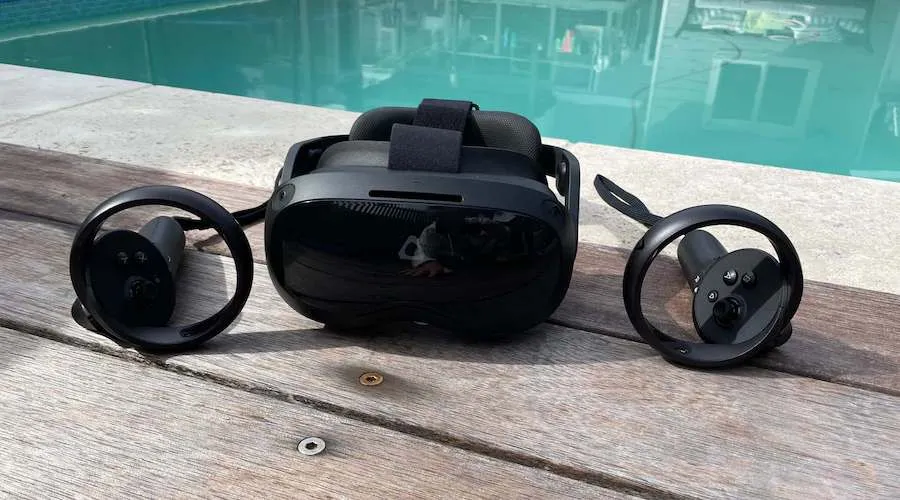
Image: Chris Stead
All these slip-ups are a shame, given that otherwise, I really like the design. The way the battery is secreted inside the head strap behind some padding is genius. It looks sleek, powerful and uncluttered. The speakers are subtle to the point of being hard to spot. The in-built tracking cameras almost go unnoticed. The buttons, dials, straps and ports — including a headphone jack should you want to use your own headset — are all easy to access.
The magnetic mechanism for removing the gasket and back of the head cushion for cleaning also works well. And it’s easy to up the storage with a microSD card or swap them between headsets. You can build on the 128GB internal storage with up to 2TB of additional space.
Set-up
If you’ve read my reviews of the HTC Vive Pro 2 and the Valve Index, you’ll know I’m not a big fan of their laborious set-up experiences and footprint. By comparison, the HTC Vive Focus 3 is a breeze to get going. Put the headset on, follow a few prompts to set a room boundary and floor height and you’re more or less off and running. Once you set up Wi-Fi, you can pair it with the Vive app for more control, although I was able to proceed without doing that.
There are no base stations to set up, update and pair. You don’t have to get Steam VR working and syncing. There’s no need to even have a laptop in the room, let alone cables connected to it in multiple places.
And I think this is important, given its use case. You can just turn up at a client’s house and give them a virtual product briefing. Or pass it across to a colleague so they can complete a training course. Or perhaps set it up at a conference so people can try it out.
Performance
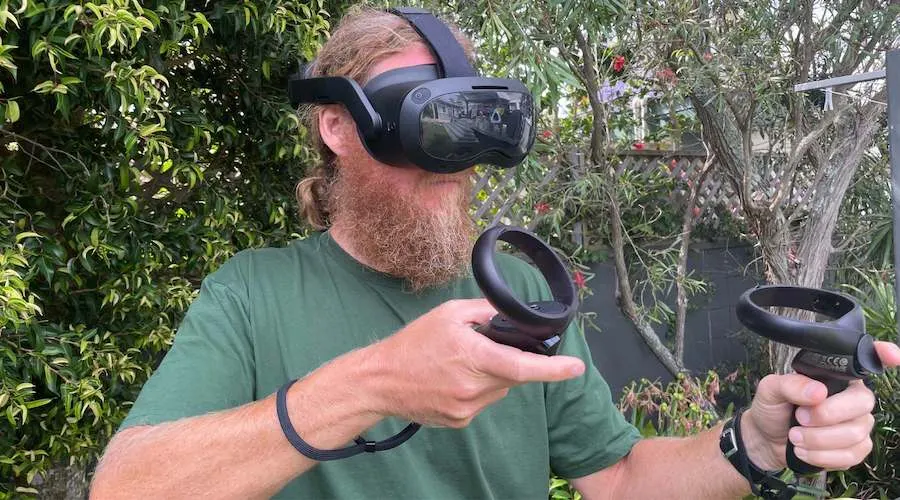
Image: Chris Stead
The big plus with the HTC Vive Focus 3 is that you’re getting a quality headset experience while retaining the ease of a wireless, in-built tracking design. The visual experience isn’t quite as sharp as the HTC Vive Pro 2, but it’s very close. The screen door effect is more or less absent — you really have to look for it — and software performs at a good clip with no tearing.
I did feel like the black outline of the mask seems to encroach more on the Vive Focus 3 than the Pro 2. I hot-swapped between the two, and for some reason, I seemed to notice it more on the Focus 3. But that feels like a minor complaint.
Tracking, for the most part, was great — good enough that you begin to wonder about the benefits of the full Base Station set-up retained by the Pro 2. Movements feel 1-to-1, and while the controllers aren’t the best — more on that in a second — an update in October 2021 has enabled hand and finger tracking. So, you can ditch the controllers should you like.
What I did find, however, is a gulf in the way different programs positioned the floor height and controller tracking. As I jumped between the 10 or so programs I tested the Vive Focus 3 on, I got a range of strange positions. I had to reset the boundaries a few times. This is relatively easy, but still, why is it happening at all? I get the impression that this is more of a software issue than hardware.
Audio
The audio is surprisingly good, considering you don’t have anything sweeping down over your ears. You even get a bit of a surround sound effect if the software you’re running facilitates it. However, you can do much better, and if you intend on using the HTC Vive Focus 3 in a busy showroom or expo floor, you’ll want a set of proper headphones instead.
The microphone also leaves a bit to be desired. It’s probably too much to say it’s muffled, but you get a deadened sound. Considering that virtual collaboration and conferencing is a highly valued use case for the Vive Focus 3, that definitely feels like a swing and a miss.
It’s another blow then that the Bluetooth isn’t up to scratch. There’s too much of a lag delay, so pairing Bluetooth headphones or accessories isn’t a solution — you’ll want to go wired.
Controllers
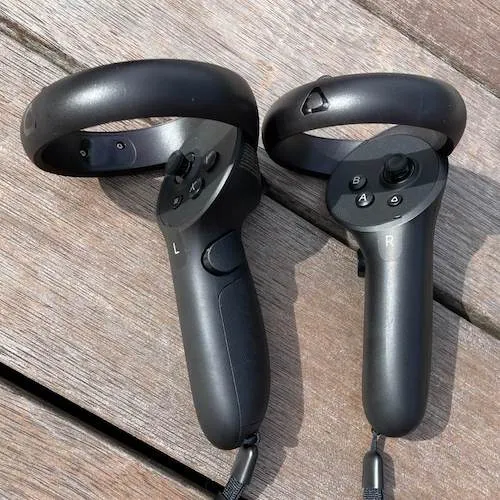
Image: Chris Stead/Finder
The HTC Vive Focus 3 ditches the “wand” controller of the Pro range and goes out on its own. The results are similar to the Oculus Quest 2 controller, which perhaps makes sense given that both devices exist in the wireless (or detached) space. But it’s not as good as Facebook’s attempt. Indeed, I was really disappointed that HTC didn’t update its wand controllers for the Pro 2 launch; I’m also happy that they didn’t opt for the Focus 3 controllers as the next step.
I can only assume that the design, with the halo sitting above your hand, is a necessary evil to enable the inside-out tracking of the headset. Because in practice, they’re not that great. The halo stops your hands from getting close together as they collide about an inch out.
I also found the trigger is a stretch for the index finger when your hand is sitting in the right spot to reach the sticks and buttons. And I have big hands.
It’s a problem amplified by the fact there’s a click point on the triggers that is a bit odd. I wouldn’t go as far as to say it’s off-putting, but I was surprised by how many times I would have to pull the trigger to get the click and the resulting action on screen, particularly while navigating menus and the hub. It’s as if you need to get it to click in the right way. In an era when the PlayStation 5’s controller has incremental, adaptive pressure triggers, this mechanism could have been done better.
At least the battery lasts 15 hours, which is more than double what you get with the wand controllers.
Is the HTC Vive Focus 3 good for general consumers?
The HTC Vive Focus 3 isn’t marketed to general consumers and gamers, but it would be nice if you could get double the value out of it, right? As a pure consumer headset, it’s not bad. The core interface and store have a few experiences — notably educational in nature — that provide genuine entertainment. But you can also play experiences off your PC.
Indeed, using the Vive Business Manager, you can stream from a PC — in my case, an Alienware gaming laptop — direct to the headset. My experience with this was largely unsuccessful. I got it to work sometimes — even playing the likes of Half-Life: Alyx off SteamVR — but it was laggy to the point of being unplayable.
That said, in troubleshooting, I came across plenty of people online who streamed without trouble. This says to me that there are a lot of “buts” and “what ifs” when it comes to your own hardware and network capabilities to guarantee this feature will work as intended.
For better results, you can tether the headset directly to your PC. You’ll want to go pick up the 5-meter-long USB Streaming Cable. It goes for $79. But in tethered mode, I played all my SteamVR games, and they worked just fine.
But let’s be honest. If it’s a consumer headset you want, you’re better off focusing on the Valve Index or HTC Vive Pro 2. Or indeed, if you want wireless play, the Oculus Quest 2.
Should you buy the HTC Vive Focus 3?
The HTC Vive Focus 3 is not a consumer headset, but you can use it as a consumer headset if you like. There are plenty of business apps with entertainment qualities that overlap beyond enterprise. Plus, you can tether or stream (if you’re lucky) content direct from a PC. But you’d be overpaying if that was your main use case. Get an HTC Vive Pro 2 if you want to play games in the best quality, or an Oculus Quest 2 if you want to game wirelessly.
Where the HTC Vive Focus 3 makes its mark is within companies and organizations. Included with the headset are the warranties, securities, IT management systems and business apps required to take a business into the future. For those companies that take the plunge on a Vive Focus 3, they are getting a premium-grade headset that, despite a few issues, can justify its price point.
Pros
- Excellent image quality
- Simple to set up and get going
- No expensive PC required
- Great business-focused features and extras
Cons
- Short battery life and can’t be charged in tethered mode
- Trigger position on controllers is awkward
- Headset mask doesn’t fold up
- Mic is a little deadened
Pricing and availability
How I tested it
I used the HTC Vive Focus 3 across a range of applications. This included educational, conferencing, training and meditation apps, as well as games and exercises. I also tested streaming and tethered modes direct with a PC. Then I cross-referenced its experience with the Oculus Quest 2, the HTC Vive Pro 2 and the HTC Cosmos Elite.
Whether products shown are available to you is subject to individual provider sole approval and discretion in accordance with the eligibility criteria and T&Cs on the provider website.
Are you visiting from outside the US?
Ask a question
More guides on Finder
-
10 best VR headsets
Learn what you need to look for when choosing your first VR headset.
-
8 best metaverse games
8 best decentralized metaverse games to earn and play.
-
Valve Index review: Wrapping your fingers around VR
The Valve Index competes in the premium virtual reality market, but is finger tracking enough to make this VR headset worth it?
-
Oculus Quest 2 review: Home VR made affordable
VR still isn’t for everyone, but Oculus’s Quest 2 bridges the gap between PC-based VR and standalone solutions with ease.
-
HTC Vive Pro 2 review: Is it worth the upgrade?
While the HTC Vive Pro 2 offers the best VR experience in the market, it’s held back by a reliance on old technology.
-
Upland vs. Decentraland
Two very unique metaverses with different objectives: Upland vs. Decentraland.
-
HTC Vive Cosmos and HTC Vive Cosmos Elite review
More than two years after release, do the HTC Vive Cosmos and the HTC Vive Cosmos Elite still have a place in the VR headset market?

